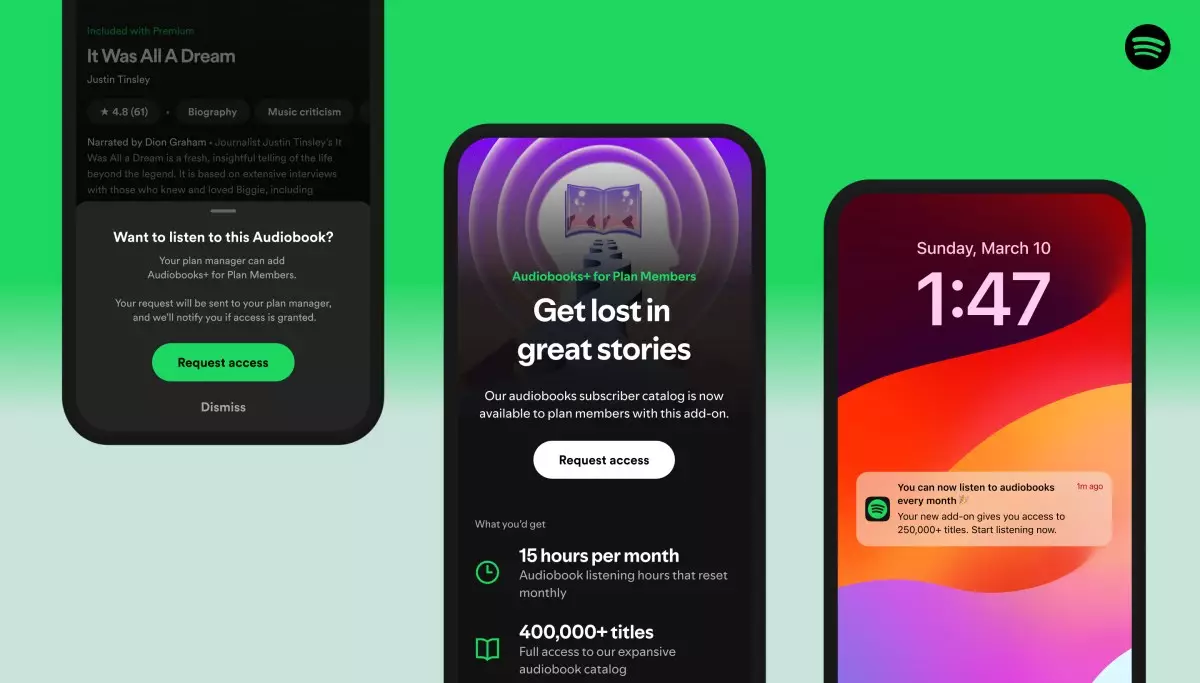Spotify’s recent expansion of its audiobook offerings signals a pivotal shift in its strategic approach, aiming to deepen user engagement and simultaneously boost revenue streams. For years, the platform has endeavored to diversify beyond music and podcasts, recognizing that listeners crave a richer, more versatile content ecosystem. The introduction of the Audiobooks+ plan—enabling household members on Family or Duo plans to access audiobooks—demonstrates a keen understanding of consumer needs and the importance of fostering a sense of shared experience within family units.
This move challenges traditional models that kept audiobook access confined to the primary subscriber, essentially leaving household members to rely on a workaround or separate subscriptions elsewhere. By integrating audiobooks seamlessly into existing plans, Spotify not only enhances perceived value but also subtly compels subscribers to consider broader usage, making audiobooks a habitual part of daily consumption. This inclusivity setup positions Spotify as an innovative leader willing to adapt its offerings to meet the evolving habits of its users, acknowledging that the modern consumer refuses to be pigeonholed into narrow content categories.
Moreover, the additional paying option—allowing users to add 15 hours of listening per month—strikes a delicate balance between flexibility and monetization. While some may view it as excessive, for the most dedicated audiobook fans, it is undoubtedly a compelling proposition. This layered approach enables Spotify to tap into niche markets without alienating casual listeners, subtly encouraging increased spending while fostering loyalty.
Market Expansion and Competitive Edge: Challenging Traditional Publishing Norms
Spotify’s expansion into multiple markets with the Audiobooks+ plan underscores a strategic push to establish a firm foothold in the increasingly lucrative audiobook industry. The company’s move aligns with broader industry trends where digital platforms seek to become one-stop entertainment hubs. By breaking down barriers that previously restricted household sharing, Spotify positions itself as a more user-centric platform—altering long-standing industry conventions synonymous with geographic and platform-specific restrictions.
This push also claims a competitive edge against specialized audiobook services like Audible or Apple Books, which have traditionally dominated the space. Spotify’s vast existing user base, combined with its innovative bundling strategies, positions the company uniquely to capture a larger share. Making audiobooks accessible to family members within existing plans not only enhances customer satisfaction but could significantly influence long-term subscription retention. As consumers increasingly seek ecosystem-driven consumption, Spotify’s integrated approach offers the convenience of a single app for multiple content forms.
Furthermore, this move hints at a future where content providers and streaming platforms might reconsider licensing and technical solutions to improve household sharing. The mention of technical hurdles, notably with HarperCollins’ involvement, indicates an ongoing industry-wide challenge that Spotify seems eager to address creatively. Whether through direct sales or hybrid models, the platform’s potential to experiment indicates a willingness to innovate beyond the traditional subscription model.
Future Implications: Converging Content, Technology, and Revenue Strategies
Looking forward, Spotify’s investments in audiobooks are more than mere expansions—they are strategic bets on long-term growth. The rapid increase in audiobook listening hours ahead of these new plans signifies an underlying demand that the platform aims to capitalize on. By offering these features now, Spotify is positioning itself as a comprehensive entertainment ecosystem capable of accommodating diverse user preferences.
The broader implications involve rethinking how digital content is consumed within households. Instead of siloed, single-user access, Spotify’s approach fosters shared experiences, possibly leading to increased overall engagement. As smartphones, smart speakers, and wearables become more integrated into daily life, Spotify’s emphasis on accessibility and household sharing could become a cornerstone of its brand identity.
Furthermore, the company’s willingness to experiment with other sales models, including direct purchases, hints at a future where transparency, flexibility, and consumer-centric innovations reshape the industry landscape. It also sets a precedent for other streaming giants contemplating similar integrations, potentially signaling a new era where digital content is more accessible, shared, and customized than ever before.
In this competitive and rapidly evolving environment, Spotify’s move to integrate audiobooks more deeply into its existing ecosystem reveals a willingness not only to adapt but to lead. By innovating within the boundaries of its platform and breaking down traditional sharing limitations, Spotify is crafting a comprehensive narrative of a platform that prioritizes user experience, technological innovation, and strategic growth—ultimately redefining what streaming success looks like in the digital age.

